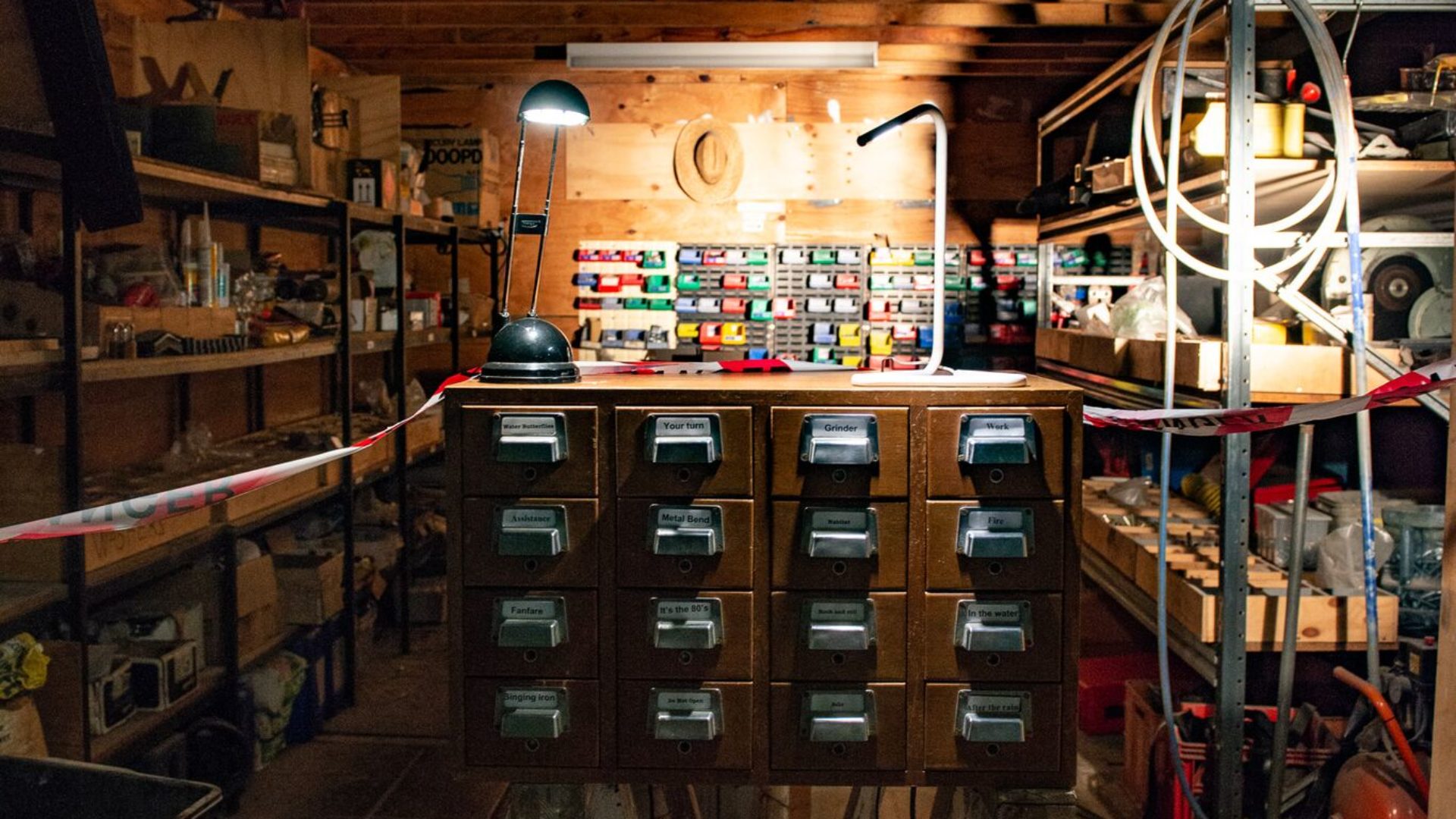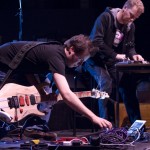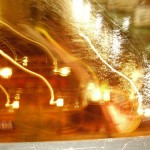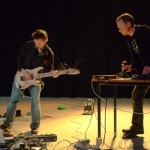Whistle Pig Saloon is the live audio collaboration of Robert van Heumen (Computer/controllers) and John Ferguson (Guitar/effects).
Wide and disjointed, blending a fractured pulse with dynamic texture, this is an immersive and disorientating music, sometimes subtle, often invasive, always close. In capturing a moment and inscribing agency, the motionblur of the cover art offers a suitable metaphor for this duo’s musical interactions. Live sampled source sounds are gesturally manipulated and reworked within open ended narratives, sounding like an air whistle blasting out from an old steam locomotive as it emerges at speed from a tunnel. Whilst the whistle pig/groundhog (day) reference explores cycles of repetition beyond episodic improvisation, emphasising the value of revisiting and re-appropriating a previous moment. John configures the electric guitar as a site for multiple simultaneous points of interaction and queries the iconic cultural status of his instrument via feet, fingers and feedback. Robert crunches, growls and smashes both John`s live sampled sound as well as his private stack of industrial bits and organic beats.
International Computer Music Conference (UK, 2011)
Culture Lab Newcastle with Bennett Hogg and Paul Vandemast-Bell (UK, 2008).
STudio for Electro-Instrumental Music AKA STEIM (NL, 2008)
Live at Borealis 2009 (Bergen Festival for Contemporary Music).
Whistle Pig Saloon CD released March 2009 on Creative Sources Recordings.
Some recent reviews:
There is an ongoing tradition in academic electroacoustic music: over thinking and too much talk. Composers spend months of preparation for a piece, forming a system and working out every detail to eschew errors and exert control over the processes of a once-exciting creative spark. This occasionally works, but more than naught – even with the elder statesmen of the genre – these factors equal a sterile homogeny and a lack of happy accidents and exciting miscues that lead to attractive tangents. Because of the complexity and otherworldly nature of their sonic palette, many then feel the best way to connect (aka apologize) an audience to their universe is through lengthy extra-musical programs that break down the results. Unfortunately, this desire ultimately stunts the mystery an audience could feel while mentally interpreting the work.
Robert van Heumen and John Ferguson, however, prefer to withhold their agenda, leaving listeners free to enjoy and translate this almost-palpably visual, cerebral yet immediately mesmeric work as they see fit. With that, to say “the duo launches into their set” is a fitting metaphor, as this music exudes the grace and violence of a NASA enterprise: at times lingering in static poses on the dark side of the moon, other moments crashing face-first into the sun. On “Perpetual Mole”, shimmering, hammered, pitch-bending guitar chords hover above barely-registered high frequency blips and swirling bursts of hiss. Soon, all systems are go and the music literally blasts off, mangling the digital limit and overwhelming the soundboard with psychoacoustic mischief (the passage will make you look up and wonder – one, who put a pack of dogs on my roof? and two, why are they stomping? – before settling into a floating gesture of pops and echoing harmonics. After a mountain of sub-woofer rumbles and ear-drum-piercing feedback – a clamor definitely heard inside a shuttle’s boosters – Ferguson interrupts “Somatic Listening” with a naked, jazzy excerpt of “Blackbird”, a phrase van Heumen immediately aborts in favor of more thunder; interestingly, the duo repeatedly skews the line of “what is tension, what is release”, and you find yourself more uneasy and rigid during the quieter, representational moments.
The two continue in this fashion throughout the disc, reeling off an endless host of keen, compound sounds with an inimitable familiarity of their technique and each other…but wait? What exactly are they doing? Sure van Heumen could offer countless diagrams of his joystick-meets-laptop method in the liner notes, and Ferguson’s unique anti-guitar attack deserves an explanation, but the duo prefers to let their demanding “I can’t do anything else but stare at the speakers while this is on” music draw up schematics, construct the diorama and tell the stories. Dave Madden (The Squid’s Ear)
Whistle Pig Saloon is Netherlands based guitarist and FX man John Ferguson and Robert van Heumen on laptop, joystick and allsorts. The groundhog (whistle pig) reference isn’t incidental and helps point to a level of repetition and sonic revisitation that might initially be resisted by anyone committed to real-time, don’t-look-back improvisation. Ferguson’s lunging, whole-body approach to the guitar should be very reassuring. Van Heumen has a box full of noises at his disposal and the whole set is sensuous fun as well as intellectually stretching. Brian Morton (The Wire)
Van Heuman is also half of this duo, along with guitarist John Ferguson. Equal parts STEIM-y electro-acousticism and raunchy guitar noise, the latter sometimes reminding me of Kaiser in his Synclavier period. Itchier than ‘Stranger’, it might find more favor among post-Zorn enthusiasts. Some good work (the piece “Hogg blog” stood out for me), but a bit too much in that hyperactive sprawl zone for my taste. Brian Olewnick (Just Outside)
A noisy and exciting duo. As good as strong tea to wake me up this morning! Van Heumen (laptop, joystick and controls) and John Ferguson (electric guitar and pedals) make quite a racket, but it’s a controlled racket, like fireqorks of metallic and luminous sounds. The energy level is similar to the Pateras/Fox duo. I’ll keep an eye on these guys. François Couture (Monsieur Delire)
The idea of repetition in the film Ground Hog Day (aka whistle pig day) is that the past as the future can be re inscribed with novelty, and appears in a more opaque form in the writings of Deleuze and Guattari – an opacity in part given by a certain reading of Nietzsche which carefully removes – “of the self same” – which is cool – as it arises out of a long line of (lit) critters, I.A. Richards, William Empson, William K. Wimsatt, Monroe Beardsley, F.R. Leavis as well as Roland Barthes, Jacques Derrida, Paul de Man, Geoffrey Hartman et al. so allowing the “re-appropriating a previous moment.” It opens up I suppose a conscious re-evaluation – re-working of difference – to and with the pioneers of modernity such as Cage and Tudor. And so techniques become -re-new-ed. However one criticism needs to be addressed which is scientism – these works were produced in a culture *lab* – how immune from the Sokal affair? – but for myself at this moment more importantly the serious reality of Nietzsche’s eternal return of the same as a not knowing identical experience, “this spider.. moonlight…”, “the most scientific” not literary idea, a la Markov. “John configures the electric guitar as a site for multiple simultaneous points of interaction and queries the iconic cultural status of his instrument via feet, fingers and feedback. Robert crunches, growls and smashes both John`s live sampled sound as well as his private stack of industrial bits and organic beats.” Either there is nothing new – or there is endless novelty – “two cultures”? Jliat (Vital Weekly)
Repetycja organiczne dz´wie³ki preparowanej gitary laptopowe t?o pustka ha?as intelektualne rozcia³gnie³cie. Astipalea Records (Felthat)



